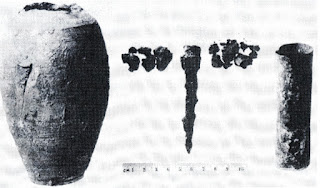10 of the most mysterious artifacts found by archaeologists
Even though most of the archaeological discoveries are today easily dated and viewed in a specific context, some excavations sometimes deliver a few surprises and plunge the archaeologists in perplexity. Anachronism, unknown languages, any small doubt immediately opens the doors to the wackiest theories, the city engulfed in the Alien civilization. Some logical explanations seem sometimes more convincing but it lets make you your small mind.
- The Antikythera Machine
Rescued at the offshore Greek in the early twentieth century and dated to the 1st century BCE, this stuff is the oldest history gear mechanism. Complex and extremely fragile, "machin" cannot be removed without being severely damaged and is still under study and modeling today.
Hypothesis: we think it's an astronomical positions calculator allowing to predict solar and lunar eclipses with incredible accuracy, especially as it will take almost 1800 years before such technology reappears on Earth.
- The site of Göbekli Tepe
This archaeological site in Turkey is surely one of the most exciting discoveries of our century, particularly because it does lend itself too wacky analyses of extraterrestrial visitors while lifting nevertheless many questions. These circles formed by huge stones is the oldest known temple more than 11,000 years old. There have been found statues animal reliefs as well as tools and knives, manufactured from a multitude of rocks which suggests that several remote tribes were located here, but for what? Housing? A place of worship? And why the place has t - he was suddenly buried by the man in-8000?
Hypothesis: the main information on this site is that man mastered the construction of massive buildings well before Stonehenge and the pyramids, and this is the most impressive, well before agriculture, contrary to what was believed until now.
- The moai of Easter Island
Even though everybody now knows the Moai of the island of Easter, many are the mysteries that have surrounded and still surround the gigantic statues. Carved by the inhabitants of the island Rapa Nui between 1250 and 1500, the imposing figures were surely respected elders, keepers of the island.In 2011, researchers find that most of the statues is under ground and they also have a body on which are discovered at the moment indecipherable petroglyphs. The greatest mystery however is the delivery of the statues, long considered impossible to move without tools.
Hypothesis: it would seem that the Rapanui have built these statues, using logs to make tools and then to move the sculptures, to the extent that they have over the years destroyed the forest that covered their island at a frenetic pace. When it was discovered in 1722 by a Dutch sailor, Jacob Roggeveen, the Rapanui cult had evolved into the worship of a 'bird man' and statues sculpture had been abandoned, probably due to lack of wood.
- The Voynich manuscript
The Voynich manuscript is surely the most mysterious book of the world behind "squirrels of Central Park are sad Monday" Katherine pancol. It is not known who is the author, it is unclear to decipher the strange alphabet in which it is written, and also is not really what it is short. It dates back to the 15th century, its name comes from the guy who discovered in a Jesuit library in 1912, and it touches to lots of things: Herbarium, astronomy, biology, cosmology, pharmacology, without that we dig well or how or why.
Hypothesis: If several people have expressed the idea of a huge Sham (especially due to the presence of plants and chimeric animals illustrated in its pages) there is no evidence that the Voynich manuscript is a big fake. All we know is that we know nothing.
- The stone spheres of Costa Rica
These gigantic Rocky balls were discovered in the 1930s in Costa Rica in the countryside of deforestation. The guys have pushed them there at the bulldozer to plant bananas, without too much worry the remains they came out. Some geologists say that these balls are composed of rocks that is not in this region which, obviously, has led some people on the track... unearthed such Atlantis, although obviously.
Hypothesis: they date no earlier than from-200 up to 1500 a.d. and would be sculptures created by the Diquis, a pre-Columbian civilization disappeared with the arrival of the Spanish colonists.
- The electric battery Baghdad
No this isn't the name of the smallest Iraqi wrestler, even if you are well forced to admit that it would have the hangover.It is in fact a pottery sherd in 1936 not far from Baghdad and likely originated in the 3rd century. Closed by a plug of bitumen, the amphora contains an iron bar and a cylinder of copper, which is still pretty strange. Add to this the connecting wires and an acid product (lemon juice or salt for example) and you get an electric battery. So, what could use electricity in the 3rd century?
Hypothesis: the most common hypothesis is that stack was used to map objects with precious metals, what is called catalysis. Some jewelry discovered at the time would tend to prove it. Only downside, the lack of wires and much too advanced for the time. The mystery remains...
- Yonaguni underwater structure
Discovered in 1985 by an organiser of tourist dives, Yonaguni structure resembles a Palace, a gigantic close construction of the Amerindian pyramids or the Babylonian Ziggurats. A team of Japanese researchers would have found hieroglyphs, a stone in the shape of face as well as drawings of animals, proving that this is an artificial structure. You start to expect, the voice immediately amounted to speak of remains of an alien city, you can also observe in detail on the video below.
Hypothesis: all geologists who have studied the Yonaguni, however, are not convinced of its artificial origin and argue that it could very well be rocky training created by the plate tectonics and the particular geometry of the latter did not prove anything.
- Klerksdorp logs
Klerksdorp logs are small spherical objects found by miners at a South African mine. These polished spheres that appear to have been made by humans often have horizontal streaks that could very well be a manifestation of primitive art. Only problem, they date from 2.8 billion years ago, IE well before the emergence of modern humans. Very quickly, some researchers call them toOOPArt, for "out of place artifact", objects "out of context", traces of a civilization unknown, not necessarily land.
Hypothesis: as surprising as they are, these spheres would be of natural origin, is in any case that suggest most geologists who have dealt with these intriguing ball.
- The Coso Artifact
Discovered by an American couple in 1961 while seeking of geodes, the Coso Artifact is also often considered to be an OOPArt: why a car candle would be at the heart of an old rock over 500,000 years? The wildest assumptions are then formulated: parts lost by travellers "from the future" full visiting prehistoric civilization vanished as Atlantis and even visit alien, everything happening there.
Hypothesis: the problem is that a single geologist was able to study the stone and that the discovery was recovered by creationists who have used it to disprove the theory of evolution. In all likelihood, the stone was in fact a nodule of iron oxide which formed around the candle while it enrouillaient, possibly in turn covered with clay dried. It is very far from the prehistoric stone.
- The Dighton rock
The Dighton rock is a huge stone of more than 40 tonnes that sat proudly in the bed of a river in Massachusetts. She was withdrawn in 1963 prior to the construction of a dam and placed in a museum. If it intrigues, is that it is on one of its faces of strange markings, (inscriptions on stone Neolithic) petroglyphs which one wonders they come. Soon, researchers say that the primitive drawings resemble Vikings, Portuguese inscriptions or even Phoenician and Chinese, from questioning the history of the discovery of the United States.
Hypothesis: however the theory today accepted by the majority, is that it's actually Native American drawings, other similar symbols that were later discovered in Vermont.
Please Share
Category: The best





















0 komentar